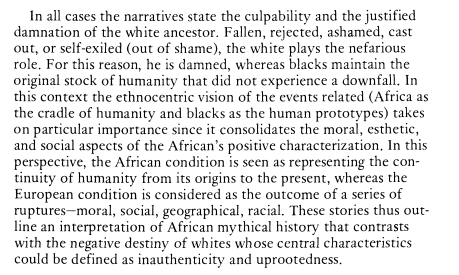Görög-Karady highlights how Vili see selves as prototypical humans and white people as cursed.
- Type
- Academic / Technical Report
- Source
- Veronika Görög-Karady Non-LDS
- Hearsay
- Secondary
- Reference
Veronika Görög-Karady, "Vili Genesis Stories: Texts and Analysis," Research in African Literatures 15, no. 2 (Summer 1984): 250
- Scribe/Publisher
- Research in African Literatures
- People
- Vili, Veronika Görög-Karady
- Audience
- Reading Public
- Transcription
In all cases the narratives state the culpability and the justified damnation of the white ancestor. Fallen, rejected, ashamed, cast out, or self-exiled (out of shame), the white plays the nefarious role. For this reason, he is damned, whereas blacks maintain the original stock of humanity that did not experience a downfall. In this context the ethnocentric vision of the events related (Africa as the cradle of humanity and blacks as the human prototypes) takes on particular importance since it consolidates the moral, esthetic, and social aspects of the African's positive characterization. In this perspective, the African condition is seen as representing the continuity of humanity from its origins to the present, whereas the European condition is considered as the outcome of a series of ruptures-moral, social, geographical, racial. These stories thus outline an interpretation of African mythical history that contrasts with the negative destiny of whites whose central characteristics could be defined as inauthenticity and uprootedness.
- Citations in Mormonr Qnas
The B. H. Roberts Foundation is not owned by, operated by, or affiliated with the Church of Jesus Christ of Latter-day Saints.

